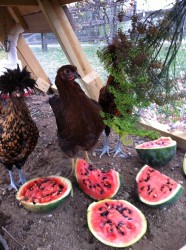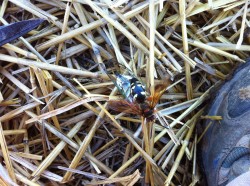Published
October 23, 2011 – 4:21 pm
Fall is my favorite season. It’s time to pull out the corduroys and hoodies and really dig in–attacking the final chores of the season. The possibility of frost could be any day so we work diligently. We are thankfully aware of the sun that warms our fingers, knowing that if it disappears the work still must be completed.
Everyone is all atitter about the beauty of the fall colors. The oranges, yellows and reds of our deciduous trees are on display for all to enjoy. It is the perennial border at Woodland Farm that really flashes in fall with a rainbow of colors. As the temperatures drop, the colors seem riche r and more vibrant. The amazing red of the dinner plate Dahlia ‘Babylon Red’ against the striking backdrop of Anemone ‘Party Dress’ (Pictured right) is a sight not to be missed. Although we have to lift the dahlia tubers each season, we leave them in the ground for as long as possible–clinging to the colors they display for as long as we can. Other Dahlia varieties that keep us in color include: Babylon Purple, Bishop of Llandoff, Crazy Love, D. soldera, Karma Corona, Kelvin Floodlight, Nuit d’Ete and a few more. These guys aren’t the only show stoppers.
r and more vibrant. The amazing red of the dinner plate Dahlia ‘Babylon Red’ against the striking backdrop of Anemone ‘Party Dress’ (Pictured right) is a sight not to be missed. Although we have to lift the dahlia tubers each season, we leave them in the ground for as long as possible–clinging to the colors they display for as long as we can. Other Dahlia varieties that keep us in color include: Babylon Purple, Bishop of Llandoff, Crazy Love, D. soldera, Karma Corona, Kelvin Floodlight, Nuit d’Ete and a few more. These guys aren’t the only show stoppers.
A few of our annuals step up and shine one last time each season. Self seeders like Bidens ferulaefolia ‘Golden Goddess’ and Nigella damascena ‘Love-in-a-mist” sprinkle yellow, blue, white and purple throughout the border.
Published
October 17, 2011 – 10:45 pm

 I’m sure the title of this post made your mouth water. Visions of beautifully glazed chicken with a sweet watermelon sauce beginning to form in your mind?
I’m sure the title of this post made your mouth water. Visions of beautifully glazed chicken with a sweet watermelon sauce beginning to form in your mind?
NOPE. These watermelons are tasty treats for the chickens and their faithful guardian donkeys. A quick swipe with the machete creates slices that are almost too perfect. The first melon barely tossed to the ground brings the chickens running–a funny sight.
Phyllis, Liza and friend (pictured right) have not joined the pasture flock but still enjoy the same treats. They like to have a small side of dill and cilantro, especially, with their watermelon. 
Published
October 12, 2011 – 11:02 pm

 Mexican Sour Gherkins (Melothria scabra) are just about the cutest little things you have ever seen. Looking more like Barbie-sized watermelons than cucumbers, the tiny fruit delivers a powerful crunch. The flavor is both sweet and sour. The dense foliage is covered with the sweetest little yellow flowers. Definitely worth a shift from the vegetable garden to the ornamental garden.
Mexican Sour Gherkins (Melothria scabra) are just about the cutest little things you have ever seen. Looking more like Barbie-sized watermelons than cucumbers, the tiny fruit delivers a powerful crunch. The flavor is both sweet and sour. The dense foliage is covered with the sweetest little yellow flowers. Definitely worth a shift from the vegetable garden to the ornamental garden.
Published
September 28, 2011 – 11:09 am
 Citrullus lanatus ‘Moon & Stars’
Citrullus lanatus ‘Moon & Stars’
The perfect watermelon for sharing with friends and family–our largest weighed in over 40 lbs. An old-fashioned variety, Moon & Stars, is full of big seed–perfect for spitting–and beautiful meaty pink flesh. We cut our first melon open with a machete and shared it with Woodland garden staff. Congratulations to Alex, our seed spitting champion.
Published
September 21, 2011 – 7:15 pm
 Buckwheat (Fagopyrum sagittatum)
Buckwheat (Fagopyrum sagittatum)
As we face the close of the summer season, production slows or ceases with our warm season crops. I have to pause to give a shout-out to Buckwheat: the uniform germination of this smother crop saved us many hours of weeding and brought in the bees for miles. A couple of nice rains and a week of drying out allowed for perfect tilling. The buckwheat should break down quickly and make room for fall planting. Thanks Buckwheat.
Published
September 13, 2011 – 5:46 pm
Our Hereford and Mulefoot hogs have been foraging for their meals in food plots. Bringing the hogs to the food is the most efficient way to feed. I’m pretty sure the hogs also love it.
Published
August 31, 2011 – 6:25 pm
Grab your little ones and run for the house. It’s a plague of mass proportions. The cicada killers are everywhere. RUN!!! Ahhhhhhh.
Tee hee, just teasing.
Our newest growing area has a decent population of Cicada Killer Wasps (Sphecius specious), and until you get used to them buzzing about, working in close proximity with the 1″ or greater beasts can be a bit frightening. Although they can deliver a pretty painful sting, they tend to ignore us and only occasionally lumber up a leg, dragging their cargo beneath them.

A beneficial narrow-waisted solitary wasp, the cicada killer does just as it’s name implies–kills cicadas. The female stings an adult cicada–paralyzing her prey–and then flips it on its back and carries it to a burrow holding a single egg. Within a few days the egg hatches and feeds on the paralyzed cicada or cicadas left by it’s mother, leaving behind only the outer shell.
With a full belly, the larva then prepares for winter by building a case of silk. Overwintering in the soil–it sets its sights to emerge next summer.
Published
August 17, 2011 – 5:36 pm
The roosters like the new, old truck as much as I do!

Published
August 15, 2011 – 9:11 pm
[quicktime width=”300″ height=”400″]https://www.woodlandfarm.com/wp-content/uploads/2011/08/IMG_33481.mov[/quicktime]
 r and more vibrant. The amazing red of the dinner plate Dahlia ‘Babylon Red’ against the striking backdrop of Anemone ‘Party Dress’ (Pictured right) is a sight not to be missed. Although we have to lift the dahlia tubers each season, we leave them in the ground for as long as possible–clinging to the colors they display for as long as we can. Other Dahlia varieties that keep us in color include: Babylon Purple, Bishop of Llandoff, Crazy Love, D. soldera, Karma Corona, Kelvin Floodlight, Nuit d’Ete and a few more. These guys aren’t the only show stoppers.
r and more vibrant. The amazing red of the dinner plate Dahlia ‘Babylon Red’ against the striking backdrop of Anemone ‘Party Dress’ (Pictured right) is a sight not to be missed. Although we have to lift the dahlia tubers each season, we leave them in the ground for as long as possible–clinging to the colors they display for as long as we can. Other Dahlia varieties that keep us in color include: Babylon Purple, Bishop of Llandoff, Crazy Love, D. soldera, Karma Corona, Kelvin Floodlight, Nuit d’Ete and a few more. These guys aren’t the only show stoppers.

 I’m sure the title of this post made your mouth water. Visions of beautifully glazed chicken with a sweet watermelon sauce beginning to form in your mind?
I’m sure the title of this post made your mouth water. Visions of beautifully glazed chicken with a sweet watermelon sauce beginning to form in your mind?







